As further proof that nostalgia isn’t what it used to be, in this week’s edition we diverge from my grandparents’ faded leather-bound family album from the 1940s and 50s and take a look at what my daughter was doing last week. Not so much ‘Nostalgia Album’ more ‘girlie holiday for girlie girls doing girlie things.’ Or is it? Perhaps an archetypal race memory draws Miss AWS to the shores of the Ionian Sea? All will be revealed.
Korfu, Corfu, Korkyra
Korfu is just another name for the Greek island of Corfu, which is one of the most popular holiday destinations in Greece, located in the Ionian Sea with spectacular sandy beaches and a unique blend of cultural influences. The island is known for its striking architecture, rich history, and beautiful landscapes, attracting thousands of tourists from around the globe. It is also home to the Canal d’Amour beach, which is steeped in romantic legend.
The holiday paradise is also notable for its unique geography which resembles a sickle, with a mountainous northern part, an undulating central region and a low-lying southern part. The island is of a maximum length of 37 miles and a maximum of 15 miles wide, although in places is only two miles across and at the narrowest point of an eastern channel only about a mile from Albania. A total area of 226 square miles makes Corfu a bit smaller than Middlesex.
Known to the Greeks as Korkyra, the island has a human history dating back to the 8th century BC when it was colonized by the Corinthians. It was a significant naval power in the ancient world, and it played a major role in the Peloponnesian War. During the Byzantine era, it was repeatedly attacked by various invaders but managed to maintain a degree of autonomy.
The Venetians ruled between 1386 and 1797, leaving a substantial influence on the island’s culture and architecture. The British took over in 1815 and established the United States of the Ionian Islands. In 1864, Corfu was ceded to Greece. During World War II, it was occupied by the Axis powers. Today, Corfu is a popular tourist destination known for its rich history and beautiful scenery.
City of Corfu
The island’s largest city, also named Corfu, with a population of 32,000, serves as the main hub for tourism and local activity and is renowned for its cosmopolitan Old Town. As the island’s capital, the city is surrounded by medieval castles that once protected it from pirate and Ottoman invasions.
The statue in the bottom photograph is of Georgios Theotokis, a Corfiote born in 1844 who served as Greek Prime Minister four times between 1899 and 1909.
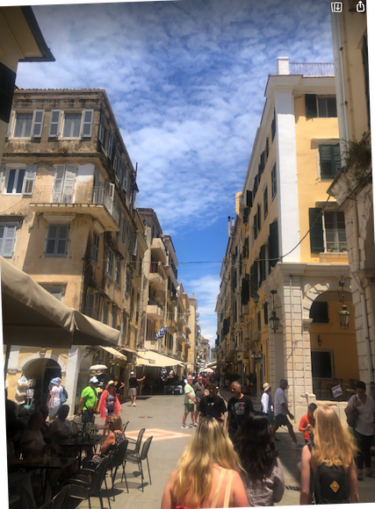
© Miss AWS 2023, Going Postal
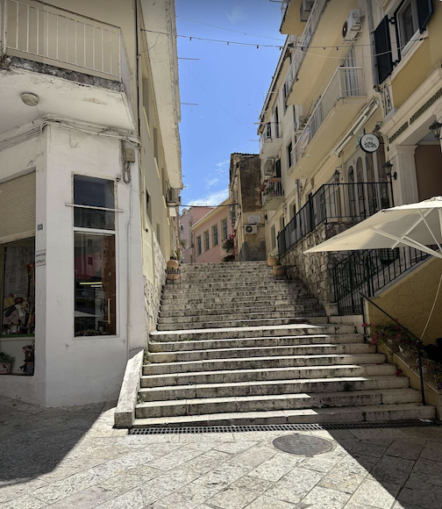
© Miss AWS 2023, Going Postal
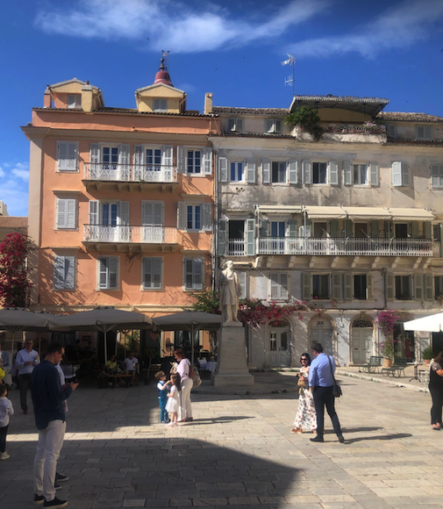
© Miss AWS 2023, Going Postal
The nearby Kerkya Castle, also known as the Old Fortress, is an important historical site constructed by the Venetians in the 15th century. The fortress stands on the site of a former Byzantine castle. It is a great example of military architecture, surrounded by the sea on all sides and accessed through a bridge over a moat. Within the fortress, there are several noteworthy structures, including a church, a prison, and a music school. The castle’s highest point, a tall clock tower, offers panoramic views of the city and the sea, making it a popular spot for tourists.

© Miss AWS 2023, Going Postal
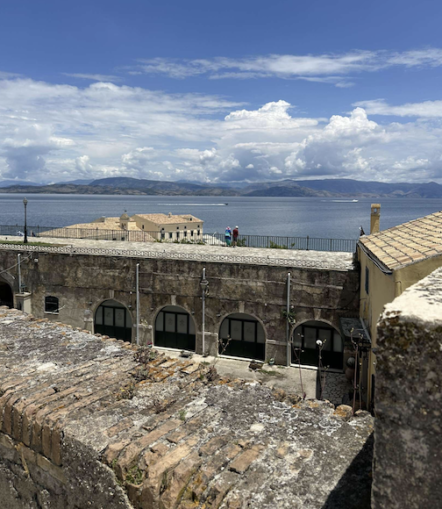
© Miss AWS 2023, Going Postal
Around the coast
A sea trip around the coast from Corfu city allows sight of Albania, pirate ships and luxury coastal villas worthy of minor royalty.

© Miss AWS 2023, Going Postal
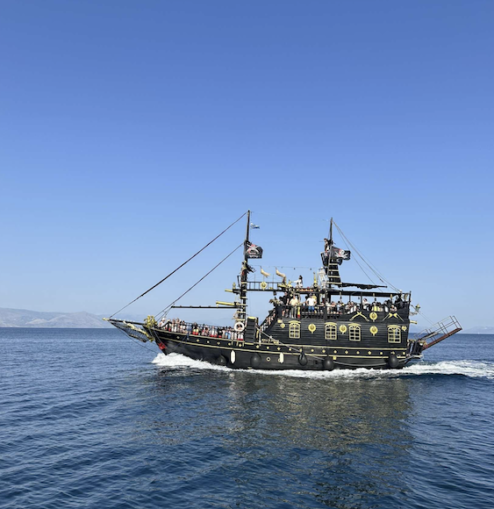
© Miss AWS 2023, Going Postal

© Miss AWS 2023, Going Postal
Did one such villa produce in Miss AWS an odd feeling of recognition as if triggered by a genetic memory passed down through the generations? I bet it did. Puffins will recall this humble author’s unexpected DNA test showing him 20% German. Puffins may also recall a philandering aristocrat of German descent with a connection to my own Debatable Lands where he competed with his carriage and horses.
Interestingly, he was born in Corfu, in the villa of Mon Repos, during the passing of which (in a pirate boat) Miss AWS reported a shiver to run across her timbers.
Mon Repos
Mon Repos, which translates as “my rest”, was built as a summer residence for the British Lord High Commissioner of the United States of the Ionian Islands, Frederick Adam, and his second wife (a Corfiot), Diamantina “Nina” Palatino between 1828 to 1831. Later, the property was given to the Greek royal family.
The House of Glücksburg, none of them were actually Greek, used the neo-classical villa nestled in woodland overlooking the Ionian Sea as a summer residence until King Constantine II was forced to flee the country in 1967. The villa subsequently became derelict but was restored in the 1990s. The villa now serves as a museum showcasing the history of the building and the surrounding area through its fourteen galleries.
It was on a table in one of those galleries on June 10th 1921 that Prince Phillip was born – carriage racer, philanderer and future husband of our own Queen Elizabeth II.

© Google Street View 2023, Google.com
Prince Phillip
Although by title a prince of Greece and Denmark and born in Corfu, Prince Phillip’s ancestry is deeply embedded with significant German lineage. His mother, Alice of Battenburg, was a German Princess from the House of Hesse. His father, Prince Andrew, a career soldier, was from the House of Schleswig-Holstein-Sonderburg-Glücksburg.
Furthermore, all of Phillip’s four older sisters wed German Princes and Dukes, further cementing the family’s ties with German nobility. Margarita became Princess of Hohenlohe-Langenburg, Theodora, the Margravine of Baden and Cecilie, an Hereditary Grand Duchess of Hesse. The youngest sister Sophie became Princess George of Hanover.
Slender, light-haired and blue-eyed like Miss AWS, might they be relatives of mine?
Phillip’s birth certificate was written in Katharevousa, the official Greek at the time which resembles ancient rather than modern. To be frank, this humble reviewer of old photographs provincial Katharevouan is a bit rusty but I was able to translate the Reverend Spiridon Tryfonas’ rather grand prose to the following:
In Corfu, on October 24 of the year 1921, I, the undersigned vicar of the Church of Our Christ the Saviour, which is located in the grounds of the Royal Estate Mon Repos, declare that His Royal Highness Prince Andreas (Andrew) of Greece, aged 39, son of our late King George I, born in Athens and residing in Corfu, appeared before me.
He presented to me a newborn male infant, and stated that he was born on Friday May 28 1921 at 10 am in his residence to Her Royal Princess Aliki (Alice), aged 36, daughter of Louis, Prince of Battenberg, born in Windsor Castle.
During his baptism the newborn was given the name Philippos (Philip) by his godparents, namely Her Royal Majesty Queen Mother Olga, represented by Her Highness Princess Olga, daughter of His Royal Highness Prince Nikolaos of Greece, and the Municipality of the Corfiates, represented unanimously by Mayor Mr Alexandros S. Kokotos, and Mr Stylianos I. Maniarizis, president of the Municipal Council.
The hereby act of registration was compiled in presence of the witness, Theodoros Chrysovitsianos, son of Nikolaos, aged 45, doctor, born in Corfu, and Konstantinos Alamanos, son of Pericles, aged 39, lawyer, born in Corfu, and both municipal councils.
The act of registration is legally signed by me, the appeared, and the witnesses.
‘Me’ being the afore mentioned Rev Spiridon Tryfonas.
What Fr Spiridon could have added was that the infant was being baptised into interesting times which included political upheaval in Greece and war with neighbouring Turkey.
On December 9th of the following year, in his London Illustrated News column, none other than G K Chesterton reported on the trial, in a revolutionary court, of Prince Phillip’s father, Prince Andrew.
In August and September of 1921 only months after his son’s birth, Prince Andrew, when commanding the Greek Second Army Corps at the Battle of Salonkia, was stopped by the Turks while advancing towards Angora.
The prince was accused by the revolutionary prosecutor of refusing to advance on the enemy on August 3rd 1921 in spite of orders from his commander-in-chief.
The court found Prince Andrew guilty of disobeying an order and acting on his own initiative. Upon being sentenced to loss of military rank and banishment for life, Prince Andrew left Athens immediately and by December 4th was reported to be on HMS Calypso with his wife en route to Corfu to collect the rest of his family who Chesterton describes as four daughters and an infant son.
An infant son famously rushed aboard in an improvised crib made out of an orange crate, thence to Brindisi.
Upon reaching safety, Prince Andrew abandoned his family and set up home with a mistress in Monte Carlo. Hmm. Puffins might recall through my grandparents’ album and my own modest collection of snaps, ourselves feeling drawn to the Principality as if salmon upstream to an ancient breeding ground.
Corinthians and Brindisi
Speaking of Brindisi and Corinthians, Puffins of a certain age with an important engagement in Istanbul and wary of Enver Hoxha’s Albania and Tito’s Yugoslavia (and before the days of cheap flights), may have adventured the Brindisi (Italy) to Patras (Greece) ferry. Corfu will have been observed on the port side heading east.
Arrival at Patras revealed a very agreeable narrow gauge railway around the Peloponnese. To the east, Old Stamboul was reached via the Corinth Canal, mainland Greece, Athens, Salonika, Thrace and the Dardanelles. To the south, Puffins with time to spare might detour across Attica tempted by the promise of the ruins of Olympia and the coast at Kalamata – sadly in the news recently following the drowning of illegal immigrants nearby.
Would we, or Prince Phillip come to think of it, swap with Miss AWS and the Airbnb EasyJet pirate boat tour generation? I think not.
© Always Worth Saying 2023



